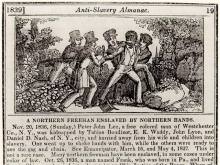Trim
1795
 Like many victims of enslavement in America, we only encounter Trim after he had been subjected to a long line of abuses. Though he was “free Born on the Cape” around 1778, at age 15 he was abducted while walking along the shoreline by sailors from a nearby ship and taken to New York City, where he was sold into slavery for 60 pounds. Describing him as a runaway and “good for nothing,” Trim’s new owner did not believe his slave’s protestations of innocence. Only when Trim learned that he was about to be sold to the West Indies did he chance punishment by further protesting his condition, and appealing to the New York Manumission Society. While reading the following account of how the society managed to secure Trim’s freedom, consider how whites understood the legality of slavery and freedom, and how those conceptions impacted the lives of those who were enslaved, whether justly or not.
Like many victims of enslavement in America, we only encounter Trim after he had been subjected to a long line of abuses. Though he was “free Born on the Cape” around 1778, at age 15 he was abducted while walking along the shoreline by sailors from a nearby ship and taken to New York City, where he was sold into slavery for 60 pounds. Describing him as a runaway and “good for nothing,” Trim’s new owner did not believe his slave’s protestations of innocence. Only when Trim learned that he was about to be sold to the West Indies did he chance punishment by further protesting his condition, and appealing to the New York Manumission Society. While reading the following account of how the society managed to secure Trim’s freedom, consider how whites understood the legality of slavery and freedom, and how those conceptions impacted the lives of those who were enslaved, whether justly or not.
Questions:
-
What is most striking about the way that Trim’s owner responds to the news that his slave was born free and kidnapped? What does this indicate about the balance between human rights and property rights in the mind of slaveholders?
-
How does Trim’s outcome help to explain philosophies toward black freedom, even by well-intentioned aid societies?

